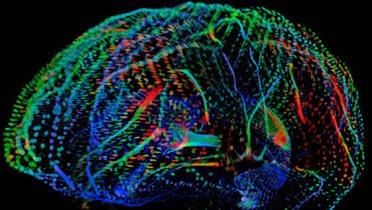INTRODUCTION
Collera, a 28 year old man with a life-long history of aggressive behavior, including assaultive conduct and abusive verbal behavior, is driving his large SUV behind a slow moving vehicle on a narrow road with no room to pass. He honks and honks, but the driver in front neither speeds up nor pulls off the road to let Collera pass. Collera starts to curse vehemently and to pull dangerously close to the slower vehicle. Collera’s passenger warns that he is taking a very serious risk. Collera finally announces in a fury that he’s going to kill the [expletive deleted] in front. He allows his vehicle to drop back a bit, and then he floors the SUV’s gas pedal, crashing into the slower vehicle at great speed. Neither he nor his passenger is hurt, but the driver of the slower vehicle is killed.
An evaluation of Collera after the killing discloses the following. A functional brain image that measures brain activation discloses that Collera has a type of neurophysiological activity in his right frontal cortex that is associated with poor behavioral self-regulation.[1] Collera’s life history includes a history of severe abuse. It is known that such abuse is strongly associated with later antisocial conduct if the person also has a genetic profile that affects particular neurotransmitter levels.[2] Collera indeed has the genetic profile and the associated neurotransmitter levels.
How should the law respond to people like Collera? Do we treat him, as we now do, as an acting agent who is properly subject to moral assessment and potential liability to just punishment? If so, how does the evaluation bear on his responsibility and future dangerousness? It appears from the limited facts that he has no specific doctrinal defense to murder. In deciding what the just punishment might be, however, how should the information from the evaluation be used? In the alternative, suppose Collera is simply a “victim of neuronal circumstances,” as some would claim. Or suppose that although we still think of him as an agent, our prediction and control technology has immeasurably advanced. What should be the proper response?
Imagine that this takes place in the future, when we will have much better information about the biologically causal variables, especially neuroscientific and genetic factors, that produce all dangerous behavior and not just seemingly extreme cases like Collera’. The description of Collera’s evaluation results makes no mention of disease or disorder. It simply reports a number of neuroscientific, genetic and gene-by-environment interaction variables that played an apparently causal role in producing Collera’s behavior and that might have helped us predict it. Will jurisprudence that respects agency, which enhances the dignity, liberty and autonomy of all citizens, survive in a future in which neuroscience and genetics dominate our thinking about personhood and responsibility. Will we abandon the concepts of criminal, crime, responsibility, blame, and punishment, and replace them by concepts such as “dangerous behavior” and “preventive control”? Will people in this brave new world be treated simply as biological mechanisms and will harmdoing be characterized simply as one mechanistic output of the system? As The Economist has warned: “Genetics may yet threaten privacy, kill autonomy, make society homogeneous, and gut the concept of human nature. But neuroscience could do all those things first.”[3]
The law in our liberal democracy responds to the need to restrain dangerous people like Collera by what I have termed “desert-disease” jurisprudence.[4] As a consequence of taking people seriously as people, as potential moral agents, we believe that it is crucial to cabin the potentially broad power of the state to deprive people of liberty. With rare exceptions, the state may only restrain a citizen if that citizen has been fairly convicted of crime and deserves the punishment imposed. If a citizen has not committed a crime but appears dangerous and not responsible for his or her dangerousness—usually as a result of mental disorder or other diseases that impair rationality—the citizen may be civilly committed. People who are simply dangerous but who have committed no crime and who are responsible agents cannot be restrained. The normative basis of desert-disease jurisprudence is that it enhances liberty and autonomy by leaving people free to pursue their projects unless an agent responsibly commits a crime or unless through no fault of his own the agent is non-responsibly dangerous. In the latter case, the agent’s rationality is impaired and the usual presumption in favor of liberty and autonomy yields to the need for societal protection and preventive detention and involuntary treatment may be warranted.
The law’s concern with justifying and protecting liberty and autonomy is deeply rooted in the conception of rational personhood. Human beings are part of the physical universe and subject to the laws of that universe, but, as far as we know, we are the only creatures on earth capable of acting fully for reasons and self-consciously. Only human beings are genuinely reason-responsive and live in societies that are in part governed by behavior-guiding norms. Only human beings have projects that are essential to living a good life. Only human beings have expectations of each other and require justification for interference in each other’s lives that will prevent the pursuit of projects and seeking the good. We are the only creatures to whom the questions “Why did you do that?” and “How should we behave” are properly addressed, and only human beings hurt and kill each other in response to the answers to such questions. As a consequence of this view of ourselves, human beings typically have developed rich sets of interpersonal, social attitudes, practices, and institutions, including those that deal with the risk we present to each other. Among these are the practice of holding others morally and legally responsible, which depends on our attitudes and expectations about deserved praise and blame, and our practices and institutions that express those attitudes, such as reward and punishment.
There is little evidence at present that neuroscience, especially functional imaging, and genetic evidence are being introduced routinely in criminal cases outside of capital sentencing proceedings. It may well happen in the near future, however, especially as the technology becomes more broadly available and less expensive. So it’s worth considering in detail neuroscience’s radical challenge to responsibility, which treats people as “victims of neuronal circumstances” or the like. If this view of personhood is correct, it would indeed undermine all ordinary conceptions of responsibility and even the coherence of law itself.
[1]
Tiffany W. Chow & Jeffrey L. Cummings, Frontal-Subcortical Circuits, in Bruce L. Miller & Jeffrey L. Cummings (eds.), The Human Frontal Lobes: Functions and Disorders (2d Ed.) 25, 27-31 (2007). Damage to this region is also associated with antisocial behavior. Steven W. Anderson et al, Impairment of social and moral behavior related to early damage in human prefrontal cortex. 2 Nat. Neurosci. 1032 (1999); R. James Blair & Lisa Cipolotti, Impaired social response reversal: a case of acquired sociopathy, 123 Brain 1122 (2000); Jeffrey L. Saver & Antonio R. Damasio, Preserved access and processing of social knowledge in a patient with acquired sociopathy due to ventromedial frontal damage, 29 Neuropsychologia 1241 (1991). Let us assume, however, that Collera is not obviously damaged.
[2]
Avshalom Caspi et al, Role of genotype in the cycle of violence in maltreated children, 297 Science 851 (2002).
[3]
The Ethics of Brain Science: Open Your Mind, Economist, May 25, 2002, at 77.
[4]
Stephen J. Morse, Neither Desert Nor Disease, 5 Legal Theory 265, 267-70 (1999).
The Brookings Institution is committed to quality, independence, and impact.
We are supported by a diverse array of funders. In line with our values and policies, each Brookings publication represents the sole views of its author(s).




